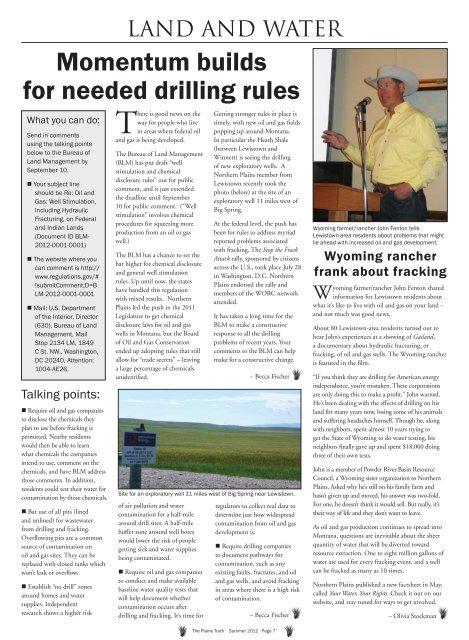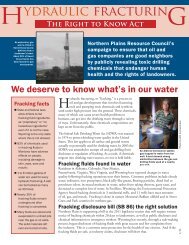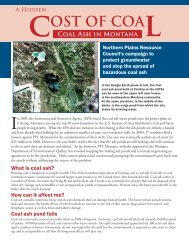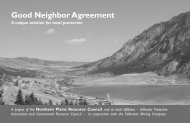Summer - Northern Plains Resource Council
Summer - Northern Plains Resource Council
Summer - Northern Plains Resource Council
Create successful ePaper yourself
Turn your PDF publications into a flip-book with our unique Google optimized e-Paper software.
land and water<br />
Momentum builds<br />
for needed drilling rules<br />
What you can do:<br />
Send in comments<br />
using the talking points<br />
below to the Bureau of<br />
Land Management by<br />
September 10.<br />
• Your subject line<br />
should be Re: Oil and<br />
Gas: Well Stimulation,<br />
Including Hydraulic<br />
Fracturing, on Federal<br />
and Indian Lands<br />
(Document ID BLM-<br />
2012-0001-0001)<br />
• The website where you<br />
can comment is http://<br />
www.regulations.gov/#<br />
!submitComment;D=B<br />
LM-2012-0001-0001<br />
• Mail: U.S. Department<br />
of the Interior, Director<br />
(630), Bureau of Land<br />
Management, Mail<br />
Stop 2134 LM, 1849<br />
C St. NW., Washington,<br />
DC 20240, Attention:<br />
1004-AE26.<br />
Talking points:<br />
• Require oil and gas companies<br />
to disclose the chemicals they<br />
plan to use before fracking is<br />
permitted. Nearby residents<br />
would then be able to learn<br />
what chemicals the companies<br />
intend to use, comment on the<br />
chemicals, and have BLM address<br />
those comments. In addition,<br />
residents could test their water for<br />
contamination by those chemicals.<br />
• Bar use of all pits (lined<br />
and unlined) for wastewater<br />
from drilling and fracking.<br />
Overflowing pits are a common<br />
source of contamination on<br />
oil and gas sites. They can be<br />
replaced with closed tanks which<br />
won’t leak or overflow.<br />
• Establish “no drill” zones<br />
around homes and water<br />
supplies. Independent<br />
research shows a higher risk<br />
There is good news on the<br />
way for people who live<br />
in areas where federal oil<br />
and gas is being developed.<br />
The Bureau of Land Management<br />
(BLM) has put draft “well<br />
stimulation and chemical<br />
disclosure rules” out for public<br />
comment, and it just extended<br />
the deadline until September<br />
10 for public comment. (“Well<br />
stimulation” involves chemical<br />
procedures for squeezing more<br />
production from an oil or gas<br />
well.)<br />
The BLM has a chance to set the<br />
bar higher for chemical disclosure<br />
and general well stimulation<br />
rules. Up until now, the states<br />
have handled this regulation<br />
with mixed results. <strong>Northern</strong><br />
<strong>Plains</strong> led the push in the 2011<br />
Legislature to get chemical<br />
disclosure laws for oil and gas<br />
wells in Montana, but the Board<br />
of Oil and Gas Conservation<br />
ended up adopting rules that still<br />
allow for “trade secrets” – leaving<br />
a large percentage of chemicals<br />
unidentified.<br />
of air pollution and water<br />
contamination for a half-mile<br />
around drill sites. A half-mile<br />
buffer zone around well bores<br />
would lower the risk of people<br />
getting sick and water supplies<br />
being contaminated.<br />
• Require oil and gas companies<br />
to conduct and make available<br />
baseline water quality tests that<br />
will help document whether<br />
contamination occurs after<br />
drilling and fracking. It’s time for<br />
Getting stronger rules in place is<br />
timely, with new oil and gas fields<br />
popping up around Montana.<br />
In particular the Heath Shale<br />
(between Lewistown and<br />
Winnett) is seeing the drilling<br />
of new exploratory wells. A<br />
<strong>Northern</strong> <strong>Plains</strong> member from<br />
Lewistown recently took the<br />
photo (below) at the site of an<br />
exploratory well 11 miles west of<br />
Big Spring.<br />
At the federal level, the push has<br />
been for rules to address myriad<br />
reported problems associated<br />
with fracking. The Stop the Frack<br />
Attack rally, sponsored by citizens<br />
across the U.S., took place July 28<br />
in Washington, D.C. <strong>Northern</strong><br />
<strong>Plains</strong> endorsed the rally and<br />
members of the WORC network<br />
attended.<br />
It has taken a long time for the<br />
BLM to make a constructive<br />
response to all the drilling<br />
problems of recent years. Your<br />
comments to the BLM can help<br />
make for a constructive change.<br />
– Becca Fischer<br />
Site for an exploratory well 11 miles west of Big Spring near Lewistown.<br />
regulators to collect real data to<br />
determine just how widespread<br />
contamination from oil and gas<br />
development is.<br />
• Require drilling companies<br />
to document pathways for<br />
contamination, such as any<br />
existing faults, fractures, and oil<br />
and gas wells, and avoid fracking<br />
in areas where there is a high risk<br />
of contamination.<br />
– Becca Fischer<br />
The <strong>Plains</strong> Truth <strong>Summer</strong> 2012 Page 7<br />
Wyoming farmer/rancher John Fenton tells<br />
Lewistown-area residents about problems that might<br />
lie ahead with increased oil and gas development.<br />
Wyoming rancher<br />
frank about fracking<br />
Wyoming farmer/rancher John Fenton shared<br />
information for Lewistown residents about<br />
what it’s like to live with oil and gas on your land –<br />
and not much was good news.<br />
About 80 Lewistown-area residents turned out to<br />
hear John’s experiences at a showing of Gasland,<br />
a documentary about hydraulic fracturing, or<br />
fracking, of oil and gas wells. The Wyoming rancher<br />
is featured in the film.<br />
“If you think they are drilling for American energy<br />
independence, you’re mistaken. These corporations<br />
are only doing this to make a profit,” John warned.<br />
He’s been dealing with the effects of drilling on his<br />
land for many years now, losing some of his animals<br />
and suffering headaches himself. Though he, along<br />
with neighbors, spent almost 10 years trying to<br />
get the State of Wyoming to do water testing, his<br />
neighbors finally gave up and spent $18,000 doing<br />
three of their own tests.<br />
John is a member of Powder River Basin <strong>Resource</strong><br />
<strong>Council</strong>, a Wyoming sister organization to <strong>Northern</strong><br />
<strong>Plains</strong>. Asked why he’s still on his family farm and<br />
hasn’t given up and moved, his answer was two-fold.<br />
For one, he doesn’t think it would sell. But really, it’s<br />
their way of life and they don’t want to leave.<br />
As oil and gas production continues to spread into<br />
Montana, questions are inevitable about the sheer<br />
quantity of water that will be diverted toward<br />
resource extraction. One to eight million gallons of<br />
water are used for every fracking event, and a well<br />
can be fracked as many as 10 times.<br />
<strong>Northern</strong> <strong>Plains</strong> published a new factsheet in May,<br />
called Your Water, Your Rights. Check it out on our<br />
website, and stay tuned for ways to get involved.<br />
– Olivia Stockman





